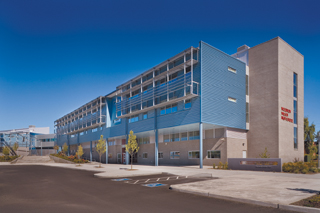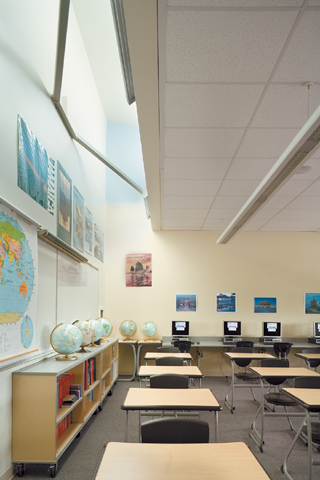|
Subscribe / Renew |
|
|
Contact Us |
|
| ► Subscribe to our Free Weekly Newsletter | |
| home | Welcome, sign in or click here to subscribe. | login |
Construction
| |
 |
September 20, 2007
Light ‘chimneys’ cool off Tacoma school
Northwest Architectural Co.

Stack
|
Originally a sprawling one-story campus, Tacoma’s Wilson High School is being redeveloped to make it more compact and easier to supervise.
The first phase of the redevelopment replaced substantial portions of the school. A 96,000-square-foot, three-story replacement building opened in September last year. The architectural and systems design of the school are interdependent, with systems depending on the building configuration and orientation to work properly.
The new building houses the administration and counseling suites, general classrooms and the library, science and business labs.
The design seeks to create a “sense of place” at the campus by creating more intimate student gathering spaces that allow students to better connect with each other and their teachers.

The design accomplishes these goals with covered outdoor student gathering spaces that were created by leaving the area under the library open on three sides to provide a dynamic interaction area for students. A central “oculus” with a glass-enclosed main stair and transparent bridge that connects the two sides of the building allows for visual connection and is also a focus for student gathering.
Containing costs
The school was designed in 2003 and 2004 just as the hyperinflation in construction costs was beginning to affect the region.
As the design progressed, cost escalation challenged the owner and design team to think of ways to economize while maintaining quality and keeping long-term operating costs low.
The existing school was not air conditioned, and suffered from poor heat gain control on the long south-facing flanks of the one-story classroom wings. The users were reluctant to consider a redevelopment without air conditioning, but budget pressure was at odds with including air conditioning in the final design.
As we studied the problem with our consultants we looked for ways to economize, and developed an integrated design strategy to solve the problem.
This strategy starts by taking advantage of the opportunities provided by the configuration of the building on the site. By removing the existing buildings at the front of the school we provide badly needed site area and create a sense of place at the school.
By replacing these buildings with a new building running east and west, we create a more intimate courtyard between the gym, commons, auditorium and new building. This orientation also maximizes north and south exposures, enabling us to use a daylighting strategy for the building.
Daylighting

As we looked into daylighting we became very interested in how to use this technique not just on the top floor, but on lower floors as well.
We modeled the building on a heliodon, a device that simulates the path of sunlight, to determine how to balance the daylighting throughout the room. These studies led us to investigate the use of light shafts to introduce light to floors below the top floor.
At the same time we were tackling the problem of how to create a comfortable educational environment without air conditioning. Our daylighting studies looked at a number of configurations for sun shades on the south elevation, and so we were confident we could control the heat gain through these windows.
Displacement ventilation
Our attention turned to techniques for ventilating the rooms. We considered ceiling fans and other techniques but settled on the concept of displacement ventilation.
Displacement ventilation works on the concept that air supplied at the floor will be heated by the occupants in the room. As the air warms it slowly rises and is removed at the top of the room. The air is intentionally stratified in displacement ventilation with fresh air continuously introduced in the occupied zone at a low velocity.
This is in contrast to the standard mixing approach in which ceiling diffusers deliver air at a higher velocity, and return grilles also on the ceiling remove the air from the room. In the standard approach fresh air and heated exhaled air is mixed, while in displacement ventilation the air does not mix.
Displacement ventilation removes sensible heat directly from occupants and exhausts it upward in the room. This has a cooling effect that mixing air systems do not have.
Additionally, displacement ventilation continuously supplies 100 percent fresh air to occupants. In a mixing system a substantial portion of the air is recirculated, effectively keeping contaminants in the room. In a displacement system exhaust air passes through heat exchangers, thereby capturing the energy from the heated air before it is exhausted.
Integrating the design
Our research showed that schools in New Hampshire and Minnesota were using the system, so we began to research their experiences. We then developed the concept for Wilson that introduced supply air from under the casework along the windows and in one of the opposite corners of the room. It was in looking at how to exhaust the air that the true integration of the design occurred.
We determined that the light shafts created to introduce light to the top two floors of the building also created “chimneys” in each classroom that served to naturally draw the warmed displaced air from the room up the light shaft. By placing the exhaust vents at the top of the shafts we created a natural flow that helped draw air in low and exhaust it high.
In this way the light shafts that provide good daylighting to the classrooms are integrated with the mechanical system to provide good ventilation to the classrooms. Thus the architecture, lighting and mechanical systems work together in an integrated way, each dependent on the other to create a more energy-efficient and comfortable building.
Greg Stack is the managing principal of Northwest Architectural Co.’s Seattle office. He has been planning and designing K-12 and higher-ed projects throughout the region for over 20 years.
Other Stories:
- Cascadia college building will be green inside and out
- Owners, designers can harness the Web too
- ‘I wish I could go to a school just like this’
- Performing arts spaces gain sophistication
- Lynnwood a proving ground for green schools
- Spokane takes a chance on GC/CM
- Seattle gets creative to expand bidding pool
- Public school projects fall out of favor with bidders
- Case for operable windows isn’t open and shut
- Tomorrow’s schools will be greener, freer


